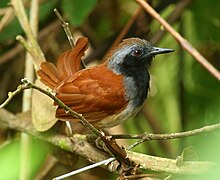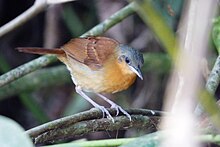White-bellied antbird
| White-bellied antbird | |
|---|---|

| |
| Male near Morne La Croix, Trinidad | |

| |
| Female | |
| Scientific classification | |
| Domain: | Eukaryota |
| Kingdom: | Animalia |
| Phylum: | Chordata |
| Class: | Aves |
| Order: | Passeriformes |
| Family: | Thamnophilidae |
| Genus: | Myrmeciza G.R. Gray, 1841 |
| Species: | M. longipes
|
| Binomial name | |
| Myrmeciza longipes (Swainson, 1825)
| |

| |
The white-bellied antbird (Myrmeciza longipes), is a passerine bird which breeds in the tropical New World from Panama to northern Brazil and in Trinidad. It is also called Swainson's antcatcher (usually in historical sources) after William John Swainson, who first described it scientifically. The genus is monotypic.
Taxonomy
The white-bellied antbird was
There are four subspecies:[5]
- M. l. panamensis Ridgway, 1908 – east Panama and north Colombia
- M. l. longipes (Swainson, 1825) – northeast Colombia, north Venezuela and Trinidad
- M. l. boucardi von Berlepsch, 1888 – northcentral Colombia
- M. l. griseipectus von Berlepsch & Hartert, 1902 – southeast Colombia, south Venezuela, the Guianas and northeast Brazil
Description
This antbird, like others in its family, is a forest bird with a preference for undergrowth in dry or moist deciduous habitats. It is a resident breeder which lays two or three eggs in a nest in a tree, both sexes incubating.
The white-bellied antbird is typically 15 cm long, and weighs 26 g. It has rufous brown upperparts and whitish underparts shading to cinnamon-buff on the flanks and lower belly. There is a long grey supercilium. The pink legs are long and strong, reflecting this bird's terrestrial lifestyle.
The male has a black face, throat and upper breast. The female has a darker crown, grey cheek patches and small dark spots on the wings, and lacks the black markings of the male. The northern race griseopectus has black spots on the wings and grey central underparts in both sexes.
The white-bellied antbird is an insectivore which feeds on ants and other arthropods at or near the ground; it sometimes follows columns of army ants. It may be located by its bright descending jeer-jeer-jeer-jeer-jeer-jeer-jeer-jeer-jeer-jeer-jeer-jeer song, which ends with a few chew notes.
References
- . Retrieved 11 November 2021.
- ^ Swainson, William John (1825). "On two new genera of birds, Formicivora and Drymophila with descriptions of several species". Zoological Journal. 2: 145–154 [152].
- ^ Gray (1841). A list of the genera of birds : with their synonyma and an indication of the typical species of each genus (2nd ed.). London: R. and J.E. Taylor. p. 34.
- PMID 26176119.
- ^ a b Gill, Frank; Donsker, David, eds. (2017). "Antbirds". World Bird List Version 8.1. International Ornithologists' Union. Retrieved 2 February 2018.
External links
- "White-bellied antbird". Avibase.

